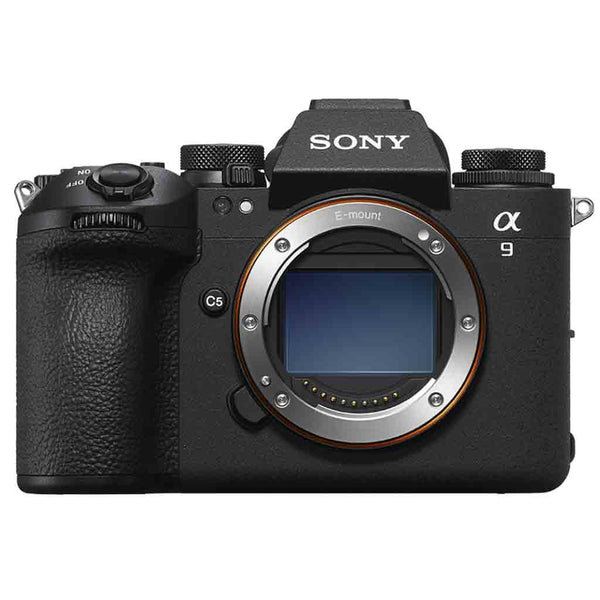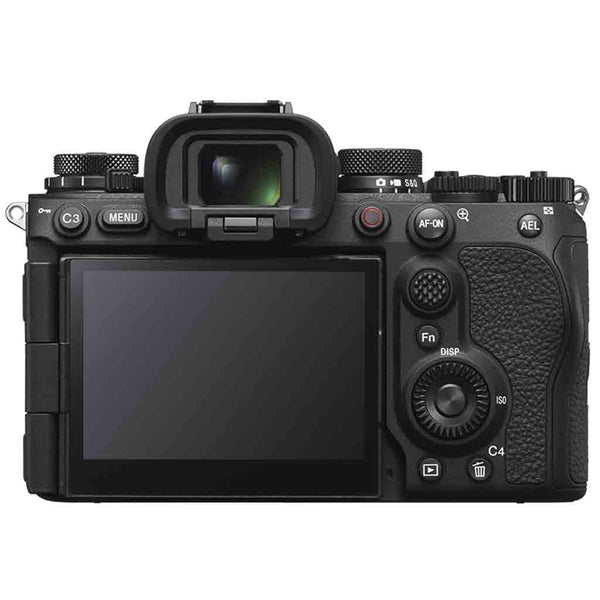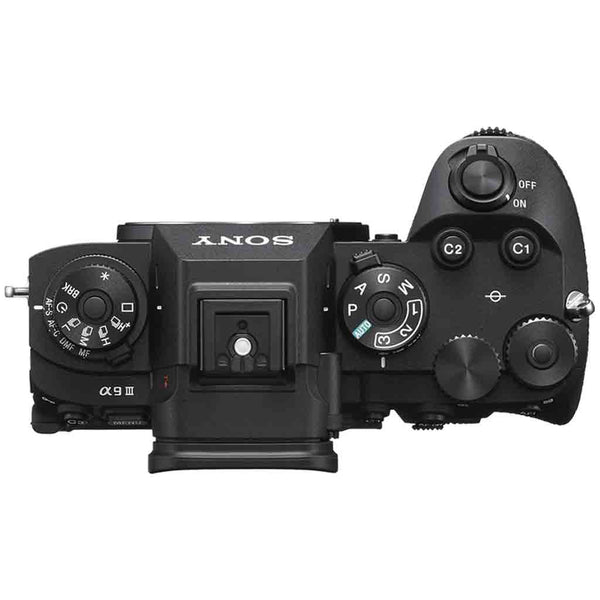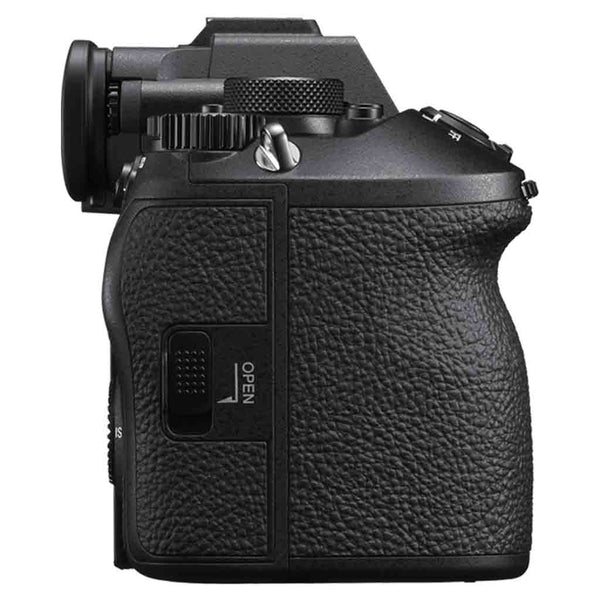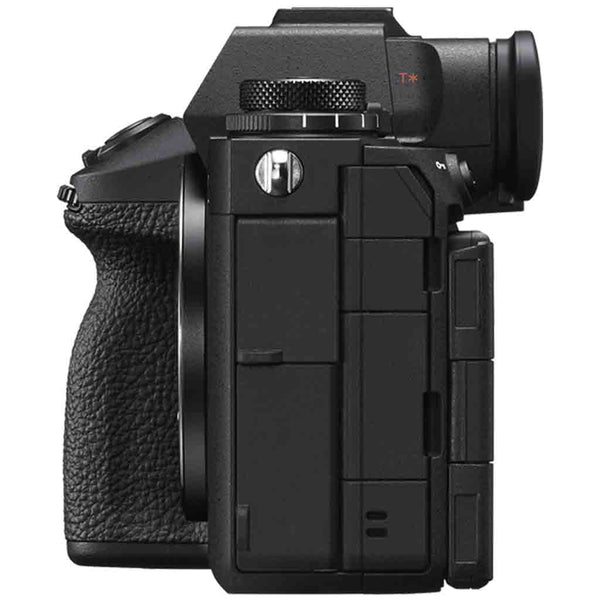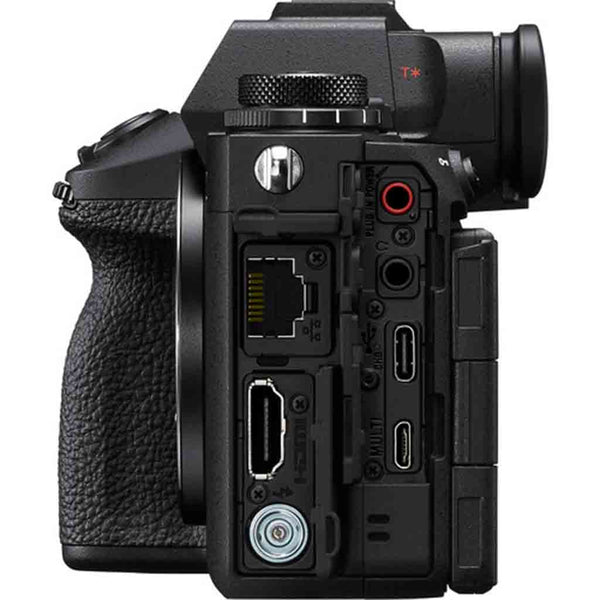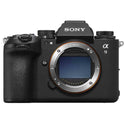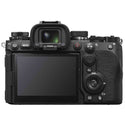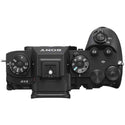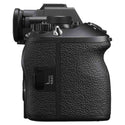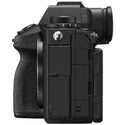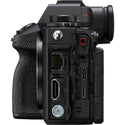Product Snapshot
format
Full Frame
resolution
24.6 MP
ISO sensitivity
125-51,200
continuous shooting
120 FPS
Collapsible content
Overview
Sony Alpha A9 III Body
Featuring the world’s first1 full-frame image sensor with a global shutter system, the Alpha 9 III is a game changer, capturing fast-moving subjects with absolutely no image distortion and preserving split-second moments in stunning detail.
Key Features
- The next capture era starts now
The α9 III features the world’s first1 full-frame stacked 24.6 MP2 CMOS image sensor with a global shutter system. Unlike a rolling shutter sensor that records images sequentially from the top row of pixels to the bottom, the newly developed Exmor RS™ image sensor exposes and reads all pixels simultaneously so the camera can capture fast-moving subjects with absolutely no distortion. Combined with a maximum shutter speed of 1/80,000 second (1/16,000 second during continuous shooting)3, the α9 III is a game changer for professional photography. (1) Pixel area (2) Hi-speed signal processing circuit (3) Image processing engine
- Blackout-free 120 fps continuous shooting
The α9 III is defined by speed and accuracy, enabling it to capture decisive moments with ease. It’s capable of shooting continuous bursts at up to 120fps with full AF/AE tracking3, all without viewfinder blackout, and its highly advanced AI processing unit recognizes subjects with astonishingly high precision and reliability.
- Preserve split-second moments
At 1/80,000 second4, the maximum shutter speed of the α9 III makes it easy to capture fast-moving subjects in almost any situation. What’s more, a compatible flash unit from Sony (such as the HVL-F60RM2 or HVL-F46RM)5 can synchronize at all shutter speeds, eliminating the steep, nonlinear drop-off in illumination that occurs with high-speed sync (HSS) and ensuring even illumination across the image.
- Exmor RS image sensor with global shutter system
The new full-frame global shutter image sensor is equipped with 24.6 million effective pixels2, a stacked CMOS architecture and integral memory. This offers high resolution, overwhelming speed, and simultaneous full-pixel readout, so even fast-moving subjects can be captured distortion-free. The sensor’s stacked structure and advanced A/D conversion enable high-speed processing to proceed with minimal delay.
- BIONZ XR™ image processing engine
The new full-frame global shutter image sensor is equipped with 24.6 million effective pixels2, a stacked CMOS architecture and integral memory. This offers high resolution, overwhelming speed, and simultaneous full-pixel readout, so even fast-moving subjects can be captured distortion-free. The sensor’s stacked structure and advanced A/D conversion enable high-speed processing to proceed with minimal delay.
With up to eight times6 more processing power than previous versions, the BIONZ XR image processing engine minimizes processing latency while markedly boosting image processing power. The high volume of data generated by the newly developed Exmor RS™ image sensor can be processed in real time even while shooting continuous bursts at up to 120fps3. This significantly improves image quality, from offering higher color gradation and more realistic color reproduction to reducing image noise. The camera can also capture high-quality 14-bit RAW images in all still shooting modes.
- Composite RAW Shooting reduces noise
Composite RAW Shooting captures multiple images (4, 8, 16, or 32, selectable) which can then be merged using Sony’s Imaging Edge Desktop™ computer application software to create full-resolution images with very low noise.7 This makes it possible to shoot wildlife at high shutter speeds or portraits in low light, achieving exceptionally high image quality with low noise, even at higher ISO settings. What’s more, when shooting at low sensitivity levels, the α9 III can take advantage of camera shake that occurs during handheld shooting and use Composite RAW to create images with reduced false color and jaggies. (1) Standard (2) Composite RAW
- Advanced optical 5-axis image stabilization
Shoot handheld with confidence. The α9 III is packed with a high-precision image stabilization unit, advanced gyro sensors and optimized image stabilization algorithms to effectively detect and correct camera shake, offering 8.0-step8 stabilization. This is further supported by compatible lenses with built-in image stabilization9 and improved communication between the body and lenses, providing effective control for blur-free shooting even at telephoto focal lengths. [1] Yaw [2] Roll [3] Pitch
- Blackout-free shooting
Enjoy an uninterrupted view through the blackout-free viewfinder, even during fast-paced continuous shooting—a game changer for shooting sports and other fast-moving subjects. What’s more, the distracting time lag that is usually associated with EVF viewing has been reduced to a minimum, so that fleeting moments can be captured with confidence.
- Up to 120 AF/AE tracking calculations per second
Let the camera keep track—the high-speed readout of the new image sensor enables the α9 III to make up to 120 AF/AE tracking calculations per second10, twice that of its predecessor. AF tracks complex subject motions and predicts sudden movements with greater precision than ever before, while AE easily responds to sudden brightness variations. The α9 III continues to track even during continuous shooting, also contributing to greater precision. (1) AF/AE calculations (2) 120 frames/s
- Never miss a moment with Pre-Capture
Pre-Capture records the moments that occurred before the shutter was released. Settable from 0.005 to 1 second, it’s available in any file format up to 120fps with full AF/AE tracking. This makes it easier to capture split-second moments, such as images of birds taking flight, even if actual shutter release is a little late.
- Flash sync at all shutter speeds
With a compatible flash unit from Sony (such as the HVL-F60RM2 or HVL-F46RM)5, the α9 III can perform full flash synchronization right up to the maximum 1/80,0004 second shutter speed. This allows flash to be used for extra subject illumination when shooting outdoors in bright daylight with a high shutter speed, reducing the need for large lighting setups and vastly expanding creative shooting possibilities.
- Flicker-free shooting
The global-shutter image sensor exposes all pixels simultaneously, so flicker cannot occur within a single image, but may appear between frames. To reduce this type of flicker, Anti-flicker Shooting or Hi frequency flicker-free shooting (Var. Shutter) functions can be used. (1) α9 III (2) Rolling shutter image sensor
- Global shutter eliminates flash banding
The α9 III’s advanced image sensor is equipped with a global shutter system that exposes and reads out all pixels at once, eliminating exposure differences that can arise, for example, when shooting alongside press photographers covering an event. This eradicates the issue of “flash banding” that is common in cameras that use a rolling shutter system.
- Uniquely flexible tilting monitor for enhanced shooting flexibility
The α9 III features a 4-axis multi-angle monitor that combines the utility of a conventional tilting monitor with side-opening vari-angle flexibility, allowing for unrestricted angle adjustment whether shooting vertically or horizontally. Slim, unobtrusive, robust22, the mechanism enables the monitor to be pulled away from the rear of the body and tilted upward by up to 98 °, downward by up to 40 °, and swung sideways by up to 180 °. The touch sensitive, 3.2 type LCD monitor is optimized for outdoor shooting, providing 2.1 million-dot resolution, a wide color gamut and ample brightness for clear, easy viewing.
- New front Custom button
An update to the Sony’s α design, the α9 III comes with a custom button on the front for faster, easier operation while holding the grip. This makes it even more adaptable to different shooting styles and needs. For example, you can assign the Continuous Speed Shooting Boost function to the front button to allow instant speed boost when shooting bursts.
- Excellent viewfinder specs and performance
The 9.44 million-dot (approx.) OLED viewfinder includes 0.90x23 magnification with a 41 ° FOV for a clear, wide view, and an updated structure that results in a 25 mm high eyepoint24. An original optical design minimizes aberration that can be distracting when looking around the viewfinder image, providing a more consistent viewing experience. Viewfinder and monitor lag time have also been reduced to allow more stable framing, especially during continuous shooting. The finder frame rate can be set to Standard (60fps), High (120fps), or Higher (240fps)25. The 240fps setting provides an extremely smooth viewfinder image with minimum motion blur when shooting moving subjects, and greatly reduces motion blur when panning or tilting.
- Improved group display
Workflow efficiency gets a drastic boost thanks to image groups. Images taken at up to 120fps in continuous bursts can be defined as “groups,” making it easier to locate a specific image within a large group of images. These groups can also be assigned a rating, which can then be used for filtering and searching, and are retained after the images are imported into a computer editing application.
-
Built-in Wi-Fi for FTP and smartphone transfers plus PC Remote tethering
Built-in Wi-Fi (IEEE 802.11ac) with 2x2 MIMO support allows high-speed data transfer, enabling the α9 III to transfer data up to twice as fast as its predecessor. 5 GHz communication offers maximum speed and stability, essential for news and sports shooters who need to deliver immediately, as well as for studio environments. The simple in-camera interface makes it easy to transfer still and movie data via an FTP server, Wi-Fi, fast-wired LAN, or USB tethering with a smartphone.
- Clearer voice memo recording
Add clear voice memo metadata to still images through a dedicated voice memo microphone that’s built into the camera’s rear panel, close to the user’s mouth for better recording quality. Voice memos can be transferred to an FTP server along with the corresponding images, allowing the photographer to communicate effectively to the editor. The photographer can also use the Transfer & Tagging (Ver. 1.9 or later) mobile application to convert the voice memos to text.
- Multiple IPTC presets
IPTC (International Press Telecommunications Council) metadata can be added to still images, with the α9 III capable of internally storing up to 20 presets that can then be quickly selected when needed. This can be extremely useful at multi-sports events, for example, where different IPTC information is required for different competitions.
What's Included
Sony a9 III Mirrorless Camera
Sony NP-FZ100 Body
Sony FDA-EP19 Eye Cup
Sony ALC-B1EM Body Cap
Sony Multi Interface Shoe Cap
Sony BC-QZ1 Battery Charger
Cable Protector
Shoulder Strap
Sony USA 1 Year Limited Warranty
Product title
Vendor
$19.99 | $24.99
Product title
Vendor
$19.99 | $24.99
Product title
Vendor
$19.99 | $24.99
Product title
Vendor

